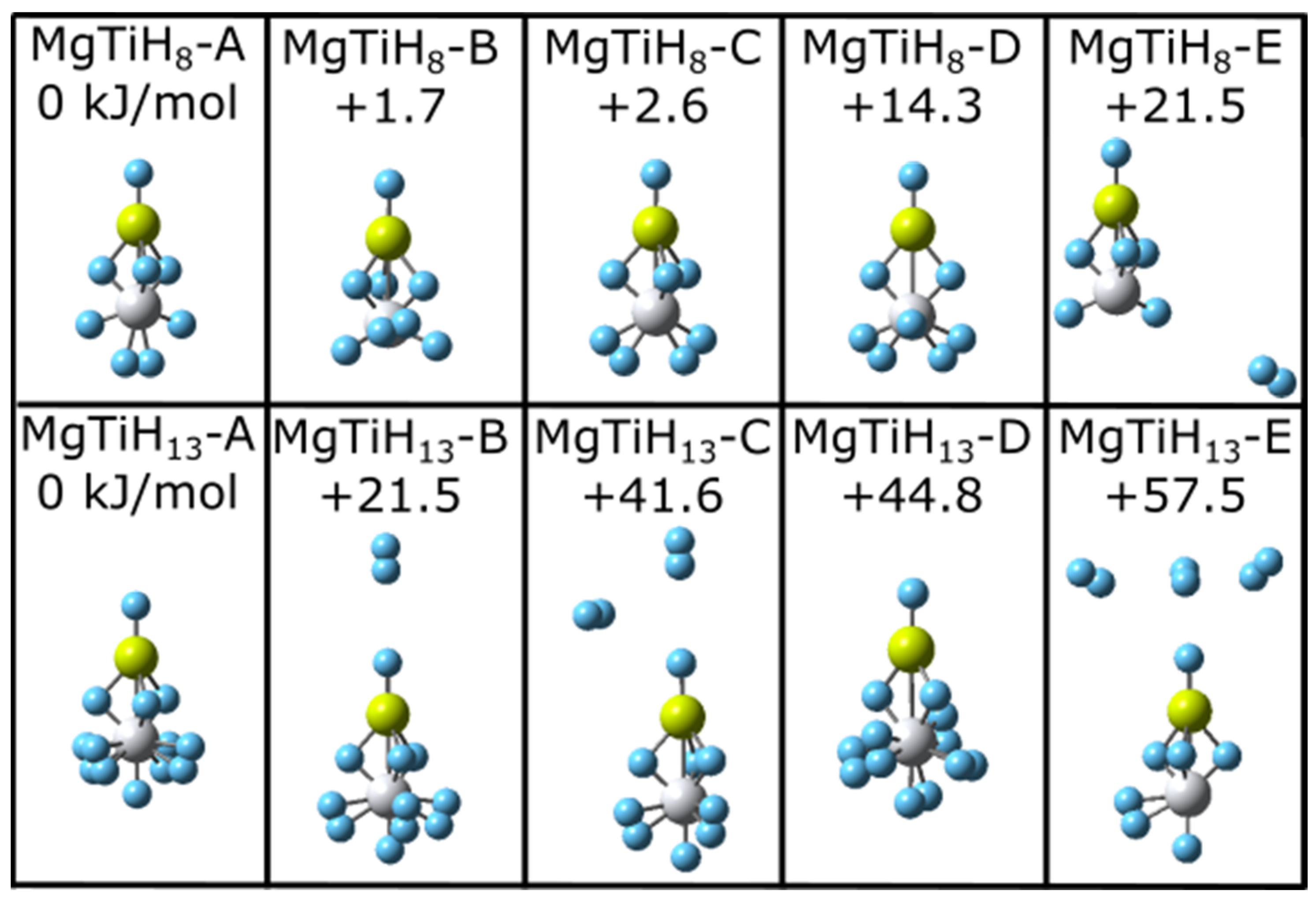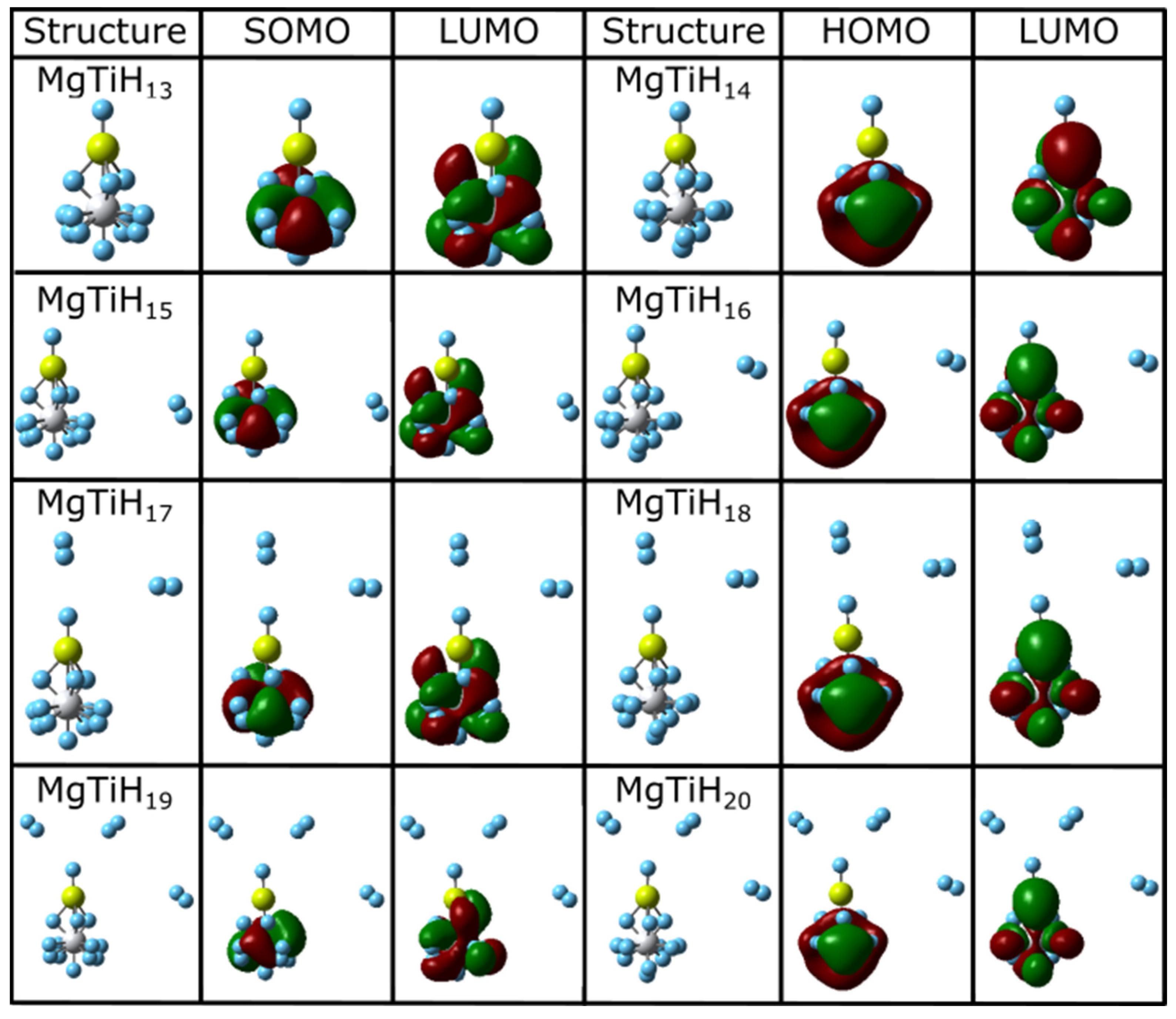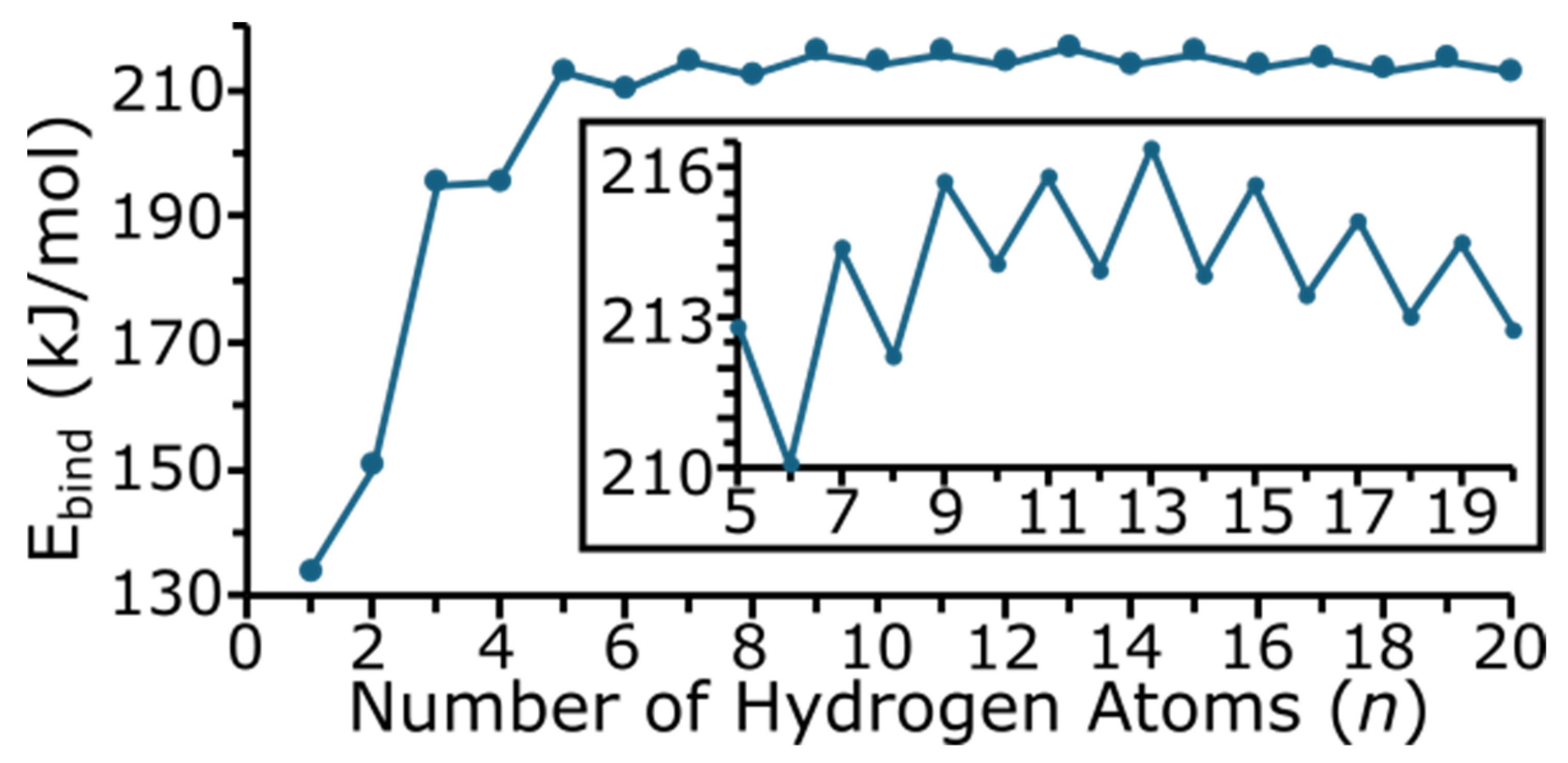Structures and Properties of MgTiHn Clusters (n ≤ 20)
Abstract
:1. Introduction
2. Computational Methods
3. Results and Discussion
3.1. Geometric Structure Determination, Growth, and Electronic Properties
3.2. MgTiHn and MgScHn Comparison
3.3. Cluster Stability and Energetics
4. Conclusions
Supplementary Materials
Author Contributions
Funding
Data Availability Statement
Acknowledgments
Conflicts of Interest
References
- Solomon, C.G.; Salas, R.N.; Malina, D.; Sacks, C.A.; Hardin, C.C.; Prewitt, E.; Lee, T.H.; Rubin, E.J. Fossil-Fuel Pollution and Climate Change—A New Nejm Group Series. N. Engl. J. Med. 2022, 386, 2328–2329. [Google Scholar] [CrossRef] [PubMed]
- Koch, S.; Klitzman, R. Reliance on Fossil Fuels: Ethical Implications for Intensivists. Intensive Care Med. 2023, 49, 330–333. [Google Scholar] [CrossRef] [PubMed]
- Zhang, Y.; Jia, Z.; Yuan, Z.; Yang, T.; Qi, Y.; Zhao, D. Development and Application of Hydrogen Storage. J. Iron Steel Res. Int. 2015, 22, 757–770. [Google Scholar] [CrossRef]
- Yartys, V.A.; Lototskyy, M.V.; Akiba, E.; Albert, R.; Antonov, V.E.; Ares, J.R.; Baricco, M.; Bourgeois, N.; Buckley, C.E.; Bellosta von Colbe, J.M.; et al. Magnesium based materials for hydrogen based storage: Past, present, and future. Int. J. Hydrogen Energy 2019, 44, 7809–7859. [Google Scholar] [CrossRef]
- von Colbe, J.B.; Ares, J.-R.; Barale, J.; Baricco, M.; Buckley, C.; Capurso, G.; Galladat, N.; Grant, D.M.; Guzik, M.N.; Jacob, I.; et al. Application of hydrides in hydrogen storage and compression: Achievements, outlook and perspectives. Int. J. Hydrogen Energy 2019, 44, 7780–7808. [Google Scholar] [CrossRef]
- Zhou, W.; Jin, S.; Dai, W.; Lyon, J.T.; Lu, C. Theoretical study on the structural evolution and hydrogen storage in NbHn (n = 2–15) clusters. Int. J. Hydrogen Energy 2021, 46, 17246–17252. [Google Scholar] [CrossRef]
- Liao, Y.H.; Zhou, W.L.; Lyon, J.T.; Peng, F.; Lu, C. The structure of anionic NbHn− (n = 2–15) clusters and their maximum hydrogen capacity. New J. Phys. 2022, 24, 043038. [Google Scholar] [CrossRef]
- Schneemann, A.; White, J.L.; Kang, S.; Jeong, S.; Wan, L.F.; Cho, E.S.; Heo, T.W.; Prendergast, D.; Urban, J.J.; Wood, B.C.; et al. Nanostructure Metal Hydrides for Hydrogen Storage. Chem. Rev. 2018, 118, 10775–10839. [Google Scholar] [CrossRef]
- Dragassi, M.-C.; Royon, L.; Redolfi, M.; Ammar, S. Hydrogen Storage as a Key Energy Vector for Car Transportation: A Tutorial Review. Hydrogen 2023, 4, 831–861. [Google Scholar] [CrossRef]
- Lobo, R.F.M. A Brief on Nano-Based Hydrogen Energy Transition. Hydrogen 2023, 4, 679–693. [Google Scholar] [CrossRef]
- Fiorio, J.L.; Goethe, M.L.; Kohlrausch, E.C.; Zardo, M.L.; Tanaka, A.A.; de Lima, R.B.; da Silva, A.G.M.; Garcia, M.A.S.; Vidinha, P.; Machado, G. Nanoengineering of Catalysts for Enhanced Hydrogen Production. Hydrogen 2022, 3, 218–254. [Google Scholar] [CrossRef]
- Pistidda, C. Solid-State Hydrogen Storage for a Decarbonized Society. Hydrogen 2021, 2, 428–443. [Google Scholar] [CrossRef]
- Cao, Z.; Habermann, F.; Burkmann, K.; Felderhoff, M.; Mertens, F. Unstable Metal Hydrides for Possible On-Board Hydrogen Storage. Hydrogen 2024, 5, 241–279. [Google Scholar] [CrossRef]
- Vajeeston, P.; Ravindran, P.; Fjellvåg, H. Predicting New Materials for Hydrogen Storage Application. Materials 2009, 2, 2296–2318. [Google Scholar] [CrossRef]
- Zhang, J.; Li, J.; Wu, Y.; Guo, X.; Ye, J.; Yuan, B.; Wang, S.; Jiang, L. Recent advances on the thermal destabilization of Mg-based hydrogen storage materials. RSC Adv. 2019, 9, 408–428. [Google Scholar] [CrossRef] [PubMed]
- Hevia, E.; Mulvey, R.E. A Record-Breaking Magnesium Hydride Molecular Cluster: Implications for Hydrogen Storage. Angew. Chem. Int. Ed. 2011, 50, 9242–9243. [Google Scholar] [CrossRef]
- Seifert, F.; Görls, H.; Kupfer, S.; Kretschmer, R. A tetranuclear magnesium hydride cluster with a four-coordinate hydride in near square-planar geometry. Chem. Commun. 2023, 59, 7627–7630. [Google Scholar] [CrossRef]
- Wang, Y.; Wang, Y. Recent Advances in Additive-Enhanced Magnesium Hydride for Hydrogen Storage. Prog. Nat. Sci. Mater. Int. 2017, 27, 41–49. [Google Scholar] [CrossRef]
- Zhang, J.; Sun, L.Q.; Zhou, Y.C.; Peng, P. Dehydrogenation Thermodynamics of Magnesium Hydride Doped with Transition Metals: Experimental and Theoretical Studies. Comput. Mater. Sci. 2015, 98, 211–219. [Google Scholar] [CrossRef]
- El Khatabi, M.; Bhihi, M.; Naji, S.; Labrim, H.; Benyoussef, A.; El Kenz, A.; Loulidi, M. Study of Doping Effects with 3d and 4d-Transition Metals on the Hydrogen Storage Properties of MgH2. Int. J. Hydrogen Energy 2016, 41, 4712–4718. [Google Scholar] [CrossRef]
- Zhou, C.; Zhang, J.; Bowman, R.C.; Fang, Z.Z. Roles of Ti-Based Catalysts on Magnesium Hydride and Its Hydrogen Storage Properties. Inorganics 2021, 9, 36. [Google Scholar] [CrossRef]
- Larsson, P.; Araúo, C.M.; Larsson, J.A.; Jena, P.; Ahuja, R. Role of catalysts in dehydrogenation of MgH2 nanoclusters. Proc. Natl. Acad. Sci. USA 2008, 105, 8227–8231. [Google Scholar] [CrossRef] [PubMed]
- Bazzanella, N.; Checchetto, R.; Miotello, A. Atoms and Nanoparticles of Transition Metals as Catalysts for Hydrogen Desorption from Magnesium Hydride. J. Nanomater. 2011, 2011, 865969. [Google Scholar] [CrossRef]
- Li, Q.; Yan, M.; Xu, Y.; Zhang, X.L.; Lau, K.T.; Sun, C.; Jia, B. Computational Investigation of MgH2/NbOx for Hydrogen Storage. J. Phys. Chem. C 2021, 125, 8862–8868. [Google Scholar] [CrossRef]
- Sun, Z.; Lu, X.; Nyahuma, F.M.; Yan, N.; Xiao, J.; Su, S.; Zhang, L. Enhancing Hydrogen Storage Properties of MgH2 by Transition Metals and Carbon Materials: A Brief Review. Front. Chem. 2020, 8, 552. [Google Scholar] [CrossRef] [PubMed]
- Charkin, O.P.; Maltsev, A.P. Density Functional Theory Modeling of Reactions of Addition of H2 Molecules to Magnesium Clusters Mg17M Doped with Atoms M of Transition 3d Elements. J. Phys. Chem. A 2021, 125, 2308–2315. [Google Scholar] [CrossRef]
- Jangir, M.; Jain, I.P.; Gattia, D.M. Effect of Ti-Based Additives on the Hydrogen Storage Properties of MgH2: A Review. Hydrogen 2023, 4, 523–541. [Google Scholar] [CrossRef]
- Yuan, Q.; Peng, C.; Yang, C.; Li, Y.; Zhang, Q.; Lv, Y.; Liu, G.; Liu, D. Facilitated hydrogen storage properties of MgH2 by Ni nanoparticles anchored on Mo2C@C nanosheets. Int. J. Hydrogen Energy 2024, 85, 12–19. [Google Scholar] [CrossRef]
- Khandelwal, P.; Rathi, B.; Agarwal, S.; Juyal, S.; Gill, F.S.; Kumar, M.; Saini, P.; Dixit, A.; Ichikawa, T.; Jain, A. Core-shell structured Ni@C based additive for magnesium hydride system towards efficient hydrogen sorption kinetics. Int. J. Hydrogen Energy, 2024; in press. [Google Scholar] [CrossRef]
- Er, S.; van Setten, M.J.; de Wijs, G.A.; Brocks, G. First-principles modelling of magnesium titanium hydrides. J. Phys. Condens. Matter 2010, 22, 074208. [Google Scholar] [CrossRef]
- Kyoi, D.; Sato, T.; Rönnebro, E.; Kitamura, N.; Ueda, A.; Ito, M.; Katsuyama, S.; Hara, S.; Noréus, D.; Sakai, T. A new ternary magnesium-titanium hydride Mg7TiHx with hydrogen desorption properties better than both binary magnesium and titanium hydrides. J. Alloys Compd. 2004, 372, 213–217. [Google Scholar] [CrossRef]
- Luo, X.; Grant, D.M.; Walker, G.S. Hydrogen storage properties of nano-structured 0.65MgH2/0.35ScH2. Int. J. Hydrogen Energy 2013, 38, 153–161. [Google Scholar] [CrossRef]
- Garçon, M.; Bakewell, C.; Sackman, G.A.; White, A.J.P.; Cooper, R.I.; Edwards, A.J.; Crimmin, M.R. A hexagonal planar transition-metal complex. Nature 2019, 574, 390–393. [Google Scholar] [CrossRef] [PubMed]
- Dore, E.M.; Lyon, J.T. The Structures of Silicon Clusters Doped with Two Gold Atoms, SinAu2 (n = 1–10). J. Clust. Sci. 2016, 27, 1365–1381. [Google Scholar] [CrossRef]
- Lyon, J.T. Building Blocks: Investigating the Structures, Properties, and Reactivity of Strongly Bound Atomic Clusters at a PUI. In Physical Chemistry Research at Undergraduate Institutions; Hopkins, T., Parish, C.A., Eds.; ACS Books: Washington, DC, USA, 2022; Volume 2, Chapter 10; pp. 165–179. [Google Scholar] [CrossRef]
- Lyon, J.T.; Gruene, P.; Fielicke, A.; Meijer, G.; Rayner, D.M. Probing C-O bond activation on gas-phase transition metal clusters: Infrared multiple photon dissociation spectroscopy of Fe, Ru, Re, and W cluster CO complexes. J. Chem. Phys. 2009, 131, 184706. [Google Scholar] [CrossRef]
- Lyon, J.T. Hydrogen Binding and Dissociation in MgScHn Clusters (n ≤ 20). Int. J. Hydrogen Energy 2021, 46, 36872–36877. [Google Scholar] [CrossRef]
- Zhang, J.; Dolg, M. ABCLUSTER: The Artificial Bee Colony Algorithm for Cluster Global Optimization. Phys. Chem. Chem. Phys. 2015, 17, 24173–24181. [Google Scholar] [CrossRef]
- Zhang, J.; Dolg, M. Global Optimization of Clusters of Rigid Molecules Using the Artificial Bee Colony Algorithm. Phys. Chem. Chem. Phys. 2016, 18, 3003–3010. [Google Scholar] [CrossRef]
- Chen, H.; Liang, H.; Dai, W.; Lu, C.; Ding, K.; Bi, J.; Zhu, B. MgScH15: A highly stable cluster for hydrogen storage. Int. J. Hydrogen Energy 2020, 45, 32260–32268. [Google Scholar] [CrossRef]
- Becke, A.D. Density-functional thermochemistry. III. The role of exact exchange. J. Chem. Phys. 1993, 98, 5648–5652. [Google Scholar] [CrossRef]
- Perdew, J.P.; Burke, K.; Wang, Y. Generalized gradient approximation for the exchange-correlation hole of a many-electron system. Phys. Rev. B. 1996, 54, 16533–16539. [Google Scholar] [CrossRef] [PubMed]
- McLean, A.D.; Chandler, G.S. Contracted Gaussian-basis sets for molecular calculations. 1. 2nd row atoms, Z = 11–18. J. Chem. Phys. 1980, 72, 5639–5648. [Google Scholar] [CrossRef]
- Raghavachari, K.; Trucks, G.W. Highly correlated systems: Excitation energies of first row transition metals Sc-Cu. J. Chem. Phys. 1989, 91, 1062–1065. [Google Scholar] [CrossRef]
- Frisch, M.J.; Trucks, G.W.; Schlegel, H.B.; Scuseria, G.E.; Robb, M.A.; Cheeseman, J.R.; Scalmani, G.; Barone, V.; Petersson, G.A.; Nakatsuji, H.; et al. Gaussian 16, Revision C.01; Gaussian, Inc.: Wallingford, CT, USA, 2016. [Google Scholar]
- Glendening, E.D.; Badenhoop, J.K.; Reed, A.E.; Carpenter, J.E.; Bohmann, J.A.; Morales, C.M.; Karafiloglou, P.; Landis, C.R.; Weinhold, F. NBO, 7.0; Theoretical Chemistry Institute, University of Wisconsin: Madison, WI, USA, 2018. [Google Scholar]
- Dennington, R.; Keith, T.A.; Millam, J.M. GaussView, Version 6.0.16; Semichem Inc.: Shawnee Mission, KS, USA, 2016. [Google Scholar]







| H Atoms (n) | NEC | Mullikan Charge (Mg/Ti) | Natural Charge (Mg/Ti) |
|---|---|---|---|
| 1 | Mg:3s1.683p0.045s0.01 | 0.146/0.0469 | 0.265/0.303 |
| Ti:4s1.033d2.594p0.064d0.01 | |||
| 2 | Mg:3s1.68 3p0.06 | 0.147/0.336 | 0.253/0.711 |
| Ti:4s0.533d2.614p0.134d0.01 | |||
| 3 | Mg:3s0.99 3p0.06 4s0.01 3d0.01 | 0.374/0.532 | 0.921/0.774 |
| Ti:4s0.383d2.804p0.035s0.014d0.01 | |||
| 4 | Mg:3s1.53 3p0.01 4s0.01 | 0.290/0.617 | 0.449/0.961 |
| Ti:4s0.643d2.324p0.074d0.01 | |||
| 5 | Mg:3s0.53 3d0.015p0.04 | 0.831/0.456 | 1.422/1.179 |
| Ti:4s0.373d2.394p0.034d0.02 | |||
| 6 | Mg:3s0.515p0.05 | 0.602/0.513 | 1.437/0.911 |
| Ti:4s0.453d2.584p0.044d0.02 | |||
| 7 | Mg:3s0.514p0.04 | 0.783/0.324 | 1.437/0.861 |
| Ti:4s0.373d2.724p0.024d0.03 | |||
| 8 | Mg:3s0.503p0.04 | 0.683/0.244 | 1.454/0.484 |
| Ti:4s0.413d3.054p0.024d0.03 | |||
| 9 | Mg:3s0.505p0.04 | 0.724/0.144 | 1.451/0.490 |
| Ti:4s0.363d3.094p0.024d0.04 | |||
| 10 | Mg:3s0.503p0.04 | 0.670/−0.036 | 1.459/0.011 |
| Ti:4s0.373d3.584p0.014d0.02 | |||
| 11 | Mg:3s0.496p0.04 | 0.689/−0.0699 | 1.467/0.039 |
| Ti:4s0.363d3.534p0.024d0.05 | |||
| 12 | Mg:3s0.496p0.04 | 0.566/−0.0458 | 1.467/−0.379 |
| Ti:4s0.373d3.974d0.025p0.02 | |||
| 13 | Mg:3s0.486p0.04 | 0.607/−0.247 | 1.476/−0.399 |
| Ti:3d3.954p0.025s0.384d0.05 | |||
| 14 | Mg:3s0.476p0.04 | 0.547/−0.584 | 1.482/−1.013 |
| Ti:4s0.363d4.624d0.015p0.01 | |||
| 15 | Mg:3s0.486p0.04 | 0.608/−0.248 | 1.475/−0.400 |
| Ti:3d3.954p0.025s0.384d0.05 | |||
| 16 | Mg:3s0.475p0.04 | 0.547/−0.581 | 1.481/−1.013 |
| Ti:4s0.363d4.624d0.015p0.01 | |||
| 17 | Mg:3s0.485p0.04 | 0.539/−0.122 | 1.482/−0.399 |
| Ti:4s0.383d3.954p0.024d0.05 | |||
| 18 | Mg:3s0.476p0.04 | 0.457/−0.433 | 1.487/−1.012 |
| Ti:4s0.363d4.624d0.015p0.01 | |||
| 19 | Mg:3s0.475p0.04 | 0.576/−0.195 | 1.482/−0.399 |
| Ti:4s0.383d3.954p0.024d0.05 | |||
| 20 | Mg:3s0.474p0.04 | 0.522/−0.551 | 1.488/−1.012 |
| Ti:3d4.625s0.364d0.015p0.01 |
Disclaimer/Publisher’s Note: The statements, opinions and data contained in all publications are solely those of the individual author(s) and contributor(s) and not of MDPI and/or the editor(s). MDPI and/or the editor(s) disclaim responsibility for any injury to people or property resulting from any ideas, methods, instructions or products referred to in the content. |
© 2024 by the authors. Licensee MDPI, Basel, Switzerland. This article is an open access article distributed under the terms and conditions of the Creative Commons Attribution (CC BY) license (https://creativecommons.org/licenses/by/4.0/).
Share and Cite
Newland, C.; Balamurugan, D.; Lyon, J.T. Structures and Properties of MgTiHn Clusters (n ≤ 20). Hydrogen 2024, 5, 669-681. https://doi.org/10.3390/hydrogen5040035
Newland C, Balamurugan D, Lyon JT. Structures and Properties of MgTiHn Clusters (n ≤ 20). Hydrogen. 2024; 5(4):669-681. https://doi.org/10.3390/hydrogen5040035
Chicago/Turabian StyleNewland, Camryn, D. Balamurugan, and Jonathan T. Lyon. 2024. "Structures and Properties of MgTiHn Clusters (n ≤ 20)" Hydrogen 5, no. 4: 669-681. https://doi.org/10.3390/hydrogen5040035
APA StyleNewland, C., Balamurugan, D., & Lyon, J. T. (2024). Structures and Properties of MgTiHn Clusters (n ≤ 20). Hydrogen, 5(4), 669-681. https://doi.org/10.3390/hydrogen5040035






